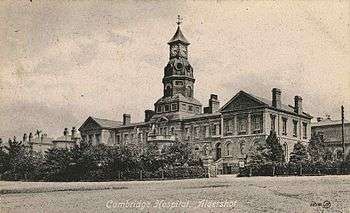Cambridge Military Hospital
| Cambridge Military Hospital | |
|---|---|
|
Cambridge Military Hospital, 1891. | |
| Active | 1879–1996 |
| Country |
|
| Branch |
|
| Type | Medical Care |
| Role | Hospital |
| Garrison/HQ | Aldershot, Hampshire |
Coordinates: 51°15′11″N 0°45′25″W / 51.253°N 0.757°W Cambridge Military Hospital was a hospital in Aldershot Garrison, Hampshire, England which served the various British Army camps there.
Earlier hospitals in Aldershot
The first military hospital in Aldershot was a wooden hutted structure, near the Garrison Church established for lunatics and infectious diseases as well as providing some family accommodation.[1]
Secondly there was the Union Hospital at Wellington Lines.[2] It was converted in the 1860s from a workhouse, the Union Poor House, which had originally been a private residence. It was small, but for the time, well-equipped.[1] It closed shortly after the opening of the Cambridge Hospital.[3]
Thirdly there was the Connaught Hospital at Marlborough Lines.[2] Established in the second half of the 19th century, it was named after Prince Arthur, Duke of Connaught and Strathearn and was for a while a specialist venereal disease hospital for 300 men.[4] It was later a dental facility before it closed on 29 September 1973.[5]
The new hospital
The Cambridge Military Hospital, built by Messrs Martin Wells and Co. of Aldershot, was located at Stanhope Lines.[2] It was named after Prince George, Duke of Cambridge and opened on 18 July 1879.[1] In the First World War, the Cambridge Hospital was the first base hospital to receive casualties directly from the Western Front.[1] The Cambridge Hospital was also the first place where plastic surgery was performed in the British Empire. Captain Gillies (later Sir Harold Gillies), met Hippolyte Morestin, while on leave in Paris in 1915. Morestin was reconstructing faces in the Val-de-Grace Hospital in Paris. Gillies fell in love with the work, and at the end of 1915 was sent back from France to start a Plastic Unit in the Cambridge Hospital.[1]
After the Second World War, with the decline in importance of Britain's military commitments, civilians were admitted to the hospital. It pioneered the supply of portable operating theatres and supplies for frontline duties. The hospital also contained the Army Chest Unit.[6] It was closed on 2 February 1996 due to the high cost of running the old building as well as the discovery of asbestos in the walls.[1]
Nearby at the top of Gun Hill is the RAMC Memorial which commemorates the 314 men of the Royal Army Medical Corps who lost their lives in the Boer War of 1899 to 1902.[7]
See also
References
- 1 2 3 4 5 6 Cambridge Military Hospital CMH Aldershot
- 1 2 3 "Aldershot" - The Project Gutenberg Encyclopedia Volume 1 of 28
- ↑ The Cambridge Military Hospital - A Short History Royal Army Medical Corps 1974. 120, 138-157
- ↑ The military hospitals at home
- ↑ The RADC Memorial Stone
- ↑ Derelict Places
- ↑ "The RAMC Memorial". Aldershot Civic Society. Retrieved 12 November 2016.
